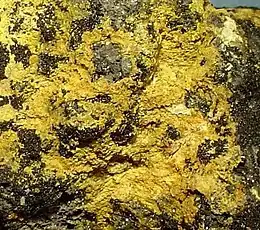Massicot
Massicot is lead (II) oxide mineral with an orthorhombic lattice structure.
| Massicot | |
|---|---|
 Massicot from the Monte Cristo mine, Goodsprings District, Clark County, Nevada (size: 5.0 x 4.0 x 4.0 cm) | |
| General | |
| Category | Oxide mineral |
| Formula (repeating unit) | PbO |
| Strunz classification | 4.AC.25 |
| Crystal system | Orthorhombic |
| Crystal class | Dipyramidal (mmm) H-M symbol: (2/m 2/m 2/m) |
| Space group | Pbcm |
| Unit cell | a = 5.4903 Å, b = 5.892 Å, c = 4.752 Å; Z = 4 |
| Identification | |
| Color | Yellow may have a red tint |
| Crystal habit | Scaly as incrustations, massive |
| Cleavage | Distinct on {100} and {010} |
| Fracture | Flexible |
| Mohs scale hardness | 2 |
| Luster | Greasy to dull |
| Streak | Yellow |
| Diaphaneity | Translucent |
| Specific gravity | 9.642 calculated |
| Optical properties | Biaxial (+) |
| Refractive index | nα = 2.510 nβ = 2.610 nγ = 2.710 |
| Birefringence | δ = 0.200 |
| Pleochroism | Y = light sulfur-yellow; Z = deep yellow |
| 2V angle | Measured: 90°, calculated: 86° |
| Dispersion | Strong |
| References | [1][2][3][4] |
Lead(II) oxide (formula: PbO) can occur in one of two lattice formats, orthorhombic and tetragonal. The tetragonal form is called litharge. PbO can be changed from massicot to litharge (or vice versa) by controlled heating and cooling. At room temperature massicot forms soft (Mohs hardness of 2) yellow to reddish-yellow, earthy, scaley masses which are very dense, with a specific gravity of 9.64. Massicot can be found as a natural mineral, though it is only found in minor quantities. In bygone centuries it was mined. Nowadays massicot arises during industrial processing of lead and lead oxides,[5] especially in the glass industry, which is the biggest user of PbO.
The definition of massicot as orthorhombic PbO dates from the 1840s,[4] but the substance massicot and the name massicot has been in use since the late medieval era.[6] There is some evidence that the ancient Romans used the substance.[7]
It may occur as an oxidation product of other lead-bearing minerals such as galena, bournonite, boulangerite, either naturally or in industrial processing. When massicot is found in a natural environment, some other minerals that may be found with it may include cerussite, litharge, minium, wulfenite, oxides of antimony and limonite.[2]
References
- Mineralienatlas
- Mineral data publishing - PDF
- Webmineral data
- Mindat with location data
- A simple example is given in A Text Book of Inorganic Chemistry, by Anil Kumar De, year 2007, page 383. A more complex example is in The Chemistry of Metal Alkoxides, published by Kluwer Academic Publishers, year 2002, section 9.4 on lead alkoxides, page 115.
- Some comments about the evolution of the definition of the word massicot over the past few centuries is in Lead Manufacturing in Britain: A History, by David John Rowe, year 1983, page 16. The word is in Italian and French in the late medieval era meaning naturally occurring massicot and in some records more vaguely a lead-based ceramics glaze that may or may not have been massicot.
- Archaeomineralogy, by George Robert Rapp, year 2002, page 173, says three lead oxides were known to the ancient Romans: minium, litharge, and massicot.
- Palache, C., H. Berman, and C. Frondel (1944) Dana’s system of mineralogy, (7th edition), v. I, 516–517